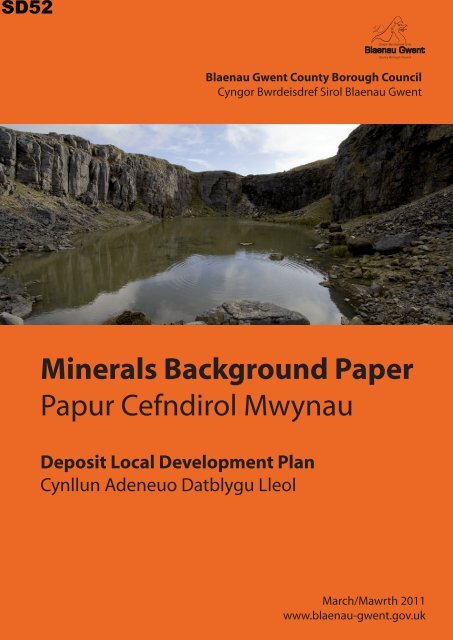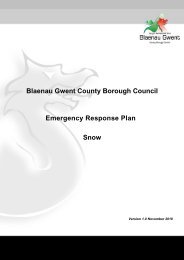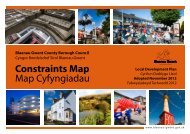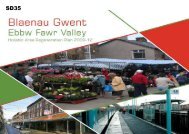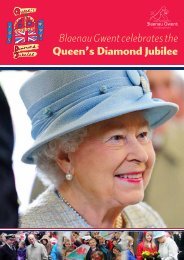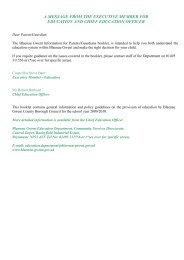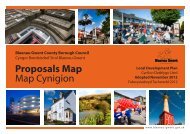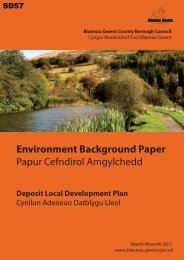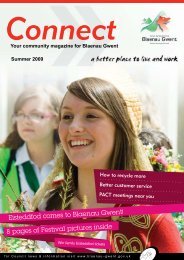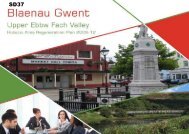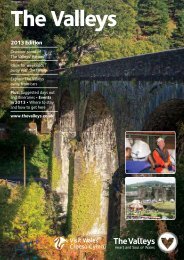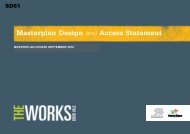SD52 - Blaenau Gwent County Borough Council
SD52 - Blaenau Gwent County Borough Council
SD52 - Blaenau Gwent County Borough Council
- No tags were found...
Create successful ePaper yourself
Turn your PDF publications into a flip-book with our unique Google optimized e-Paper software.
<strong>Blaenau</strong> <strong>Gwent</strong> <strong>County</strong> <strong>Borough</strong> <strong>Council</strong>Cyngor Bwrdeisdref Sirol <strong>Blaenau</strong> <strong>Gwent</strong>Minerals Background PaperPapur Cefndirol MwynauDeposit Local Development PlanCynllun Adeneuo Datblygu LleolMarch/Mawrth 2011www.blaenau-gwent.gov.uk
MINERALS BACKGROUND PAPERCONTENTSPage1.0 INTRODUCTION 12.0 POLICY CONTEXTNationalRegional2263.0 GEOLOGY OF THE BOROUGH 84.0 SAFEGUARDINGAggregatesCoal5.0 CURRENT SUPPLY OF AGGREGATES AND COALAggregatesCoal6.0 MINERAL REQUIREMENTS AND ALLOCATIONSAggregatesCoal and Energy Minerals7.0 RESULTS OF PREVIOUS CONSULTATIONDraft Preferred Strategy8.0 DRAFT LOCAL DEVELOPMENT PLAN POLICIESObjective 15SP12 Securing an Adequate Supply of MineralsDM19 Criteria for the Assessment of Mineral ApplicationsDM20 Mineral SafeguardingM1 Safeguarding of MineralsM2 Mineral Buffer ZonesM3 Areas where Coal Working will not be AcceptableM4 Preferred Areas9991111111212141515171717182021212222APPENDICESAppendix 1: Safeguarding Areas (Aggregates)Appendix 2: Safeguarding Areas (Coal)Appendix 3: Trefil QuarryAppendix 4: Six Bells & Vivian Tips Arrael Farm, Six BellsAppendix 5: Trefil Quarry Lateral ExtensionAppendix 6: Tir Pentwys TipAppendix 7: South East of Cwm
MINERALS BACKGROUND PAPER1.0 INTRODUCTIONAim1.1 The aim of this Background Paper is to set out the background and evidence for theMineral policies in the Deposit Plan.Overview of how this Paper fits into Plan preparation1.2 This paper will provide information for Officers and Members of the Authority,stakeholders, members of the public and the Inspector to help explain the approachtaken on Minerals.Context1.3 Minerals play a vital role in the nation’s economy and touch upon all our liveswhether it be for the provision of energy or its use in the construction industry,meeting our household and commercial needs. However, the extraction of mineralresources is often emotive as minerals can only be worked where they occur, whichoften leads to conflict with other land uses. The extraction of the mineral raisesissues in terms of its impact on the environment, residential amenity, landscape andtraffic generation.1.4 <strong>Blaenau</strong> <strong>Gwent</strong> <strong>County</strong> <strong>Borough</strong> <strong>Council</strong> as Mineral Planning Authority isresponsible for the control of mineral workings within it’s area under the provisionsof the Town and Country Planning Act 1990. Such control is exercised by thepreparation of statutory development plan policies, and decisions on planningapplications and enforcement of conditions.1.5 This Background Paper aims to identify how <strong>Blaenau</strong> <strong>Gwent</strong> can provide for themineral needs of the current economy, whilst ensuring that extraction is sustainablycontrolled and managed.1.6 This Background Paper examines:• Policy Context• Geology of the <strong>Borough</strong>• Safeguarding• Existing Quarries and Workings• Results of Previous Consultation• Recommended Policies1
MINERALS BACKGROUND PAPER2.0 POLICY CONTEXTNATIONALMinerals Planning Policy Wales (2001)2.1 The Welsh Assembly Government’s overarching policy on minerals is set out inMineral Planning Policy Wales (2000). It provides guidance on how local authoritiesshould meet the objective of providing a sustainable pattern of mineral extraction. Itsets out 5 key principles on how this can be achieved:i. Provide mineral resources to meet society’s needs and to safeguard resourcesfrom sterilisation;ii. Protect areas of importance of natural or built heritage;iii. Limit the environmental impact of mineral extraction;iv. Achieve high standard restoration and beneficial after-use; andv. Encourage efficient and appropriate use of minerals and the re-use andrecycling of suitable materials.2.2 In order to achieve these principles. <strong>Blaenau</strong> <strong>Gwent</strong> <strong>Borough</strong> <strong>Council</strong>, as MineralsPlanning Authority, will need to ensure the following requirements are met:-1. Meeting Society’s Needs and Safeguarding Resources2.3 Appropriate supply must be identified to meet local, regional and UK needs forminerals. In the case of <strong>Blaenau</strong> <strong>Gwent</strong>, the South Wales Regional AggregatesWorking Party identifies the need for aggregates. Where the location and quality isknown, and environmental constraints considered, mineral deposits and resourcesand access to them need to be safeguarded for future society’s need. These areasof land need to be identified on proposals maps with appropriate policies.Non-energy Minerals2.4 Policies and proposals maps should clearly identify where mineral extraction should,or is most likely, to take place. There are four possible classes of this:• Specific site allocation where the principle of development is accepted;• Preferred areas of known resource;• Broad areas of search;• Other areas where permission would not normally be allowed, apart from whenmajor shortfalls exist.Energy Minerals2.5 Due to the uncertainty within the energy and power industry and the minerals rolewithin it, it is difficult to plan to meet this need. However, the guidance states thatas much information as possible should be considered in the Plan to give anindication as to where extraction will and will not be acceptable.2
MINERALS BACKGROUND PAPEROther requirements2.6 Policies are required in the LDP for the maintenance of Landbanks, which may beconsidered on a regional level. A Landbank usually applies to non energy mineralsand is a stock of planning permissions for extraction.2.7 Policies should also consider how Borrow Pits (temporary workings to supplyspecific construction projects) are considered in terms of location, need oralternative supply. Strategies and policies should also outline the authority’sintentions on ‘Inactive Sites’ with planning permission.2. Protection of Important Areas2.8 Mineral proposals within or likely to affect international sites (Special Areas ofConservations (SAC’s or proposed SAC’s)), will only be considered where there areno alternative solutions or there is an imperative reason for overriding publicinterest. The <strong>Blaenau</strong> <strong>Gwent</strong> local planning authority area does not presentlycontain any SAC’s, although there is a SAC on <strong>Blaenau</strong> <strong>Gwent</strong>’s north-eastboundary. Proposals within or likely to affect national designations Sites of SpecialScientific Interest (SSSIs) and National Nature Reserves (NNR’s), should berigorously examined and assessed. This should be on the scale of possibledetrimental nature conservation effect against its need in terms of UK supply, theimpact of the local economy and alternative supplies. Proposals that fall withinlocally designated areas will need to be given careful consideration and the degreeof protection should be commensurate with their relevant importance to thebiodiversity and/or landscape area concerned.3. Limit Environmental Impact2.9 Generally, any minerals proposals should take into specific consideration the needto protect the quality of surface and groundwater, historic buildings and landscapes,ancient monuments and other cultural interests and agricultural land.2.10 The Minerals Planning Policy document outlines a range of issues that needs to beaddressed in development plans to ensure that minerals proposals, and in particularthe working practices, do not have an unacceptably adverse impact on theenvironment. Conditions will also be put on planning permissions to achieve this.Certain proposals will also be subject to Environmental Impact Assessment (EIA).2.11 Buffer zones are required to address conflict between mineral working and otherland uses due to noise, dust and blasting. Within these zones, no new developmentof sensitive land uses, such as residential, hospitals or schools, or indeed other newextraction sites, are allowed.2.12 The guidance considers that extensions to mineral workings sites are oftengenerally more acceptable than new greenfield sites, although moreenvironmentally suitable new sites could be considered.3
MINERALS BACKGROUND PAPER2.13 Welsh Assembly Government policy encourages freight carried by rail in preferenceto road. It also advises that the capacity and impact of movement of minerals needsto be carefully considered.4. Restoration and after-use2.14 Suitable restoration should be identified before planning permission is permitted,which should subsequently begin within 6 months of cessation of work. After-usesshould be identified in advance of permissions and may include agriculture,forestry/woodland, public open space, recreation or other development. There isalso an opportunity to create nature conservation sites. Conditions need to be setwhen planning permissions are granted, and financial issues secured with regard toguaranteeing the agreed restoration.5. Efficient use of Minerals and Re-use and Recycling of suitable Materials2.15 It should be ensured that high quality minerals are not wasted and are only usedwhere necessary, not for a lower grade purpose. Industrial by-products such asslag from steel making, colliery tip material, ash from power stations and slate wasteshould increasingly be considered for use as secondary aggregates, to relieve thepressure on primary extraction. Construction and demolition waste should also beincreasingly used to meet the demand for lower grade aggregate material.2.16 The development plan is required to take into consideration the need to encourageboth the practice of on-site recycling of construction and demolition material andalso provide locations for the storage and processing of these recyclable materialsin general. If such locations cannot be identified, then criteria based policies shouldbe included to set out how planning applications will be assessed.Ministerial Interim Minerals Planning Policy Statement (MIMPPS) 01/2009 – onHealth Impact Assessment for Opencast Coal Sites2.17 It is the policy of the Welsh Assembly Government that Health Impact Assessmentshould be provided to accompany any application for opencast coal working. If themineral planning authority decides that an applicant has failed to provide adequateinformation on health impacts, it may decide that it cannot process and proceed todetermine the application without that information. This may inform theEnvironmental Statement.Mineral Technical Advice Note (MTAN) (Wales) 1: Aggregates (March 2004)2.18 This document provides advice on the mechanisms for delivering the policy foraggregate extraction by mineral planning authorities and the aggregate industry.The document covers the same five themes as the Mineral Planning Policydocument but provides more information on the background and processes of theindustry and considers each issue in more detail.2.19 Aggregates are categorised into three, primary aggregates, mineral waste andsecondary/recycled aggregates.4
MINERALS BACKGROUND PAPERbetween now and 2050 and outlines the actions we must all take if we are to reachthe Assembly’s ambition of becoming a high recycling nation by 2050 and a zerowaste, one planet nation by 2050. The Strategy is relevant to minerals planningbecause it stresses the importance of using resources more efficiently throughwaste prevention and high re-use and recycling rates, promoting the re-use ofConstruction and Demolition Waste and the use of secondary aggregates inpreference to primary aggregates, in order to protect primary resources. TheStrategy will be implemented through the development of Sector plans, which willdescribe the role of the sector, the Assembly and others in delivering the outcomes,targets and policies in Towards Zero Waste. These will be developed on a prioritybasis with ‘Construction and Demolition’ amongst the first to be produced.REGIONALRegional Technical Statement for Aggregates (October 2008)2.28 The Regional Technical Statement (RTS) has been produced by the South WalesRegional Aggregates Working Party (SWRAWP). This document has beenprepared to help guide relevant authorities on how to implement Welsh AssemblyGovernment policy and advice in preparing Local Development Plans policies andallocations.2.29 A key issue in the RTS is the proposed apportionment of aggregate production ratesbetween individual authorities. This will be achieved through existing permittedreserves within the authorities or through allocating new areas for quarrying.2.30 In order to ensure that the objectives of the RTS are achieved, the document makesspecific recommendations in respect of <strong>Blaenau</strong> <strong>Gwent</strong> <strong>County</strong> <strong>Borough</strong> <strong>Council</strong>:In order to meet a proportionate share of demand, the MPA should assess thepotential to make a resource allocation of at least 3Mt in the LDP. Where feasiblethis should be of limestone.Additional Carboniferous Limestone Resources need to be examined andsafeguarded.Alternative Carboniferous Sandstone resources need to be examined andselectively safeguarded for possible future use.2.31 The RTS also summarises the current position in <strong>Blaenau</strong> <strong>Gwent</strong>:Currently, one limestone quarry is active. The present site is in close proximity to,but outside, the BBNP boundary. Despite a recent extension, reserves are wellbelow the recommended 15 year minimum landbank. The operators are currentlyinvestigating an extension to the quarry. Other limestone resources are present, butare extremely limited beyond the existing permitted areas and are sensitive from anenvironmental capacity point of view.6
MINERALS BACKGROUND PAPER2.32 Carboniferous sandstone resources occupy much of the MPA area, more than halfof which has environmentally low capacity. Both limestone and sandstone resourcesrequire more detailed investigation.2.33 Some secondary aggregate sources may be available for limited substitution(colliery shale), but the sources are not significant and the quality is poor comparedwith quarried rock.2.34 Construction and Demolition (CD) & Extraction Waste (EW) is available in the areaand a new site has recently commenced recycling.2.35 Although the MPA is not on the coast, the greater part of the area is within 30km ofthe marine wharves in Newport.2.36 On the basis of existing or per capita-based requirements, additional reserves ofabout 3Mt would need to be provided for. In terms of it’s existing share, <strong>Blaenau</strong><strong>Gwent</strong> could not continue to meet even this and therefore could not additionallyabsorb some of the BBNP, if called to do so from existing permitted reserves.2.37 In order to ensure that an appropriate planning framework exists for mineral andaggregates operations in <strong>Blaenau</strong> <strong>Gwent</strong>, the LDP will need to consider therecommendations contained in the RTS.2.38 The strategic nature of the RTS means that it does not put forward specific sites butpoints to a general provision to meet anticipated shortfall. This process has beenthe subject of strategic analysis by way of an environmental capacity assessmentbased on implementing the methodology for assessing the Environmental Capacityfor Primary Aggregates (IMAECA) system. The IMAECA system is not intended tobe used for, or indeed be suitable for, the detailed identification of potential resourceallocations or in the determining of planning applications.7
MINERALS BACKGROUND PAPERolder sites. The secondary resource runs to the north and south of the primaryresource, the southern area is again heavily constrained by urban areas.4.7 Areas where coal working will not be acceptable are identified on the Proposalsmaps. In accordance with national guidance the LDP identifies a 500m bufferaround settlements and exclude national designations of environment, historic andcultural importance - thus excluding the SSSI at Cwm Merdog Woodlands and CwmClydach, Ancient Monuments and Historic Landscapes.10
MINERALS BACKGROUND PAPER5.0 CURRENT SUPPLY OF AGGREGATES AND COALAGGREGATESLimestone – Trefil Quarry5.1 The limestone outcrop on the northern rim of the coalfield is exploited at TrefilQuarry (see map at Appendix 3). This quarry extracts limestone for concrete andbuilding stone. As a result of a recent permission for the deepening of the quarry,existing permitted reserves now stand at 3.006 million tonnes, as at end of 2008.Based on past extraction rates (last 3 years of working) as of 2009 there was a15.63 - year supply. This meets the 15-year minimum land bank required bynational policy. However, it falls below the 10-year land bank national guidancesuggests is required at the end of the Plan period.5.2 A 200m buffer will be identified around the quarry on the proposals map.COALSix Bells & Vivian Tips Arrael Farm, Six Bells5.3 There is currently one open cast coal recovery operation in progress at Six Bells &Vivian Tips Arrael Farm, Six Bells (see map at Appendix 4). The tips are estimatedto contain 1.1 million cubic metres of material of which approximately 300,000tonnes of coal is potentially recoverable by means of washing. Extraction ofminerals is required to cease by April 2012 and restoration be completed bySeptember 2012. The restored area shall be maintained for a period of 5 years, inaccordance with a scheme, which shall be approved by the local planning authority.5.4 A lateral extension to this site was granted in 2010 for 50,000 tonnes of recoverablecoal. The extraction of the mineral and restoration was estimated to last for 4months and will be completed within the timeframe set for the above scheme.5.5 A 500m buffer will be identified around the site on the proposals map.Johnson Mine, Forgeside, Blaenavon5.6 The Johnson Mine Forgeside, Blaenavon in Torfaen currently has planningpermission. It has permission for 50,000 tons of coal per annum for the periodending 2025. Approximately 20% of the land with permission to be mined lies within<strong>Blaenau</strong> <strong>Gwent</strong> <strong>County</strong> <strong>Borough</strong>. Torfaen and <strong>Blaenau</strong> <strong>Gwent</strong> Mineral PlanningAuthorities are currently reviewing the conditions of the consent.5.7 This site will not be identified on the proposals map as the entrance and associatedbuffer required are outside <strong>Blaenau</strong> <strong>Gwent</strong>’s boundary.11
MINERALS BACKGROUND PAPER6.0 MINERAL REQUIREMENTS AND ALLOCATIONSAGGREGATES6.1 Minerals Planning Policy Wales requires the maintenance of Landbanks which are astock of planning permissions for extraction. Previously, econometric forecastinghas predicted the likely demand for minerals for a given period and this has beenallocated to individual mineral planning authorities, largely on the basis of pastproduction. This approach has been considered to be unreliable and unsustainable.The new approach requires the production of a Regional Technical Statement(RTS) which assumes only low growth in the use of primary aggregates andallocates the production to individual mineral planning authorities on the basis ofenvironmental capacity. It is assumed that any additional growth in demand will bemet from secondary or recycled aggregate, although there are indications thatalternative sources of aggregates have limited potential for growth (RTS).6.2 The RTS requires <strong>Blaenau</strong> <strong>Gwent</strong> to make a resource allocation of 3Mt. A recentextension at Trefil Quarry made a resource allocation of 2.24Mt bringing the currenttonnage available at the site to 3.006Mt (2008 return). As a result of this extension<strong>Blaenau</strong> <strong>Gwent</strong> has 3Mt of resource available.Candidate Sites6.3 During the consultation process for the LDP, the <strong>Council</strong> invited stakeholders to putforward sties that may come forward for development during the plan period.Trefil Quarry – Lateral Extension6.4 The owners of the site put forward a proposal to extend the quarry in a north-eastdirection (see map attached at Appendix 5).6.5 The Environment Agency commented that any planning application would require awater feature survey and a hydrogeological risk assessment. The site is sensitive asit is located on a Source Protection Zone (SPZ) and major aquifer. A dischargeconsent is in place, any development may have an impact on the suitability of thisconsent.6.6 The Countryside <strong>Council</strong> for Wales (CCW) commented that the site runs nearMynydd Llangynidr a Geological Conservation Review (GCR) site adjacent toMynydd Llangatwg, 1 of 4 of the Usk Bat Sites SAC. The extension could affecthibernation sites for Lesser Horseshoe Bats thus having a detrimental impact ontheir Favourable Conservation Status.6.7 The Glamorgan and <strong>Gwent</strong> Archaeological Trust noted that, west of the area is ascheduled ancient monument. Little field survey of the area has been undertaken.They advise that an Archaeological desk-based assessment including field surveyplus possible evaluation of specific sites will be required prior to determination ofplanning application.12
MINERALS BACKGROUND PAPER6.8 The applicant has since submitted further evidence in support of this proposal interms of the resource, ecology and hydrology.6.9 The ‘Former <strong>Gwent</strong>’ Aggregates Study suggested the possibility of a furtherallocation at Trefil. If the <strong>Council</strong> were to allocate a specific site it would besuggesting that any planning application that came forward is likely to beacceptable. However, there is insufficient evidence for the <strong>Council</strong> to make thisdecision. Therefore, it is suggested that the area is identified as a Preferred Area,this is an area where planning permission might reasonably be anticipated.Pennant SandstoneTir Pentwys Tip6.10 A further proposal has been put forward through the candidate site process forreclamation & recovery of secondary aggregates at the former open cast site atTirpentwys Cut (see map at Appendix 6). The development of this site is dependenton the larger part of the scheme gaining planning approval from Torfaen <strong>County</strong><strong>Borough</strong> <strong>Council</strong>. This is key as access and the first stages of the reclamation workwill take place within Torfaen.6.11 The Countryside <strong>Council</strong> for Wales (CCW) noted that the site includes anacid/neutral flush/spring with an adjoining standing water body and that there was arecord of protected species on the site. The site has recently been identified as aSite of Interest for Nature Conservation.6.12 The Environment Agency (EA) noted that the site lies on a minor aquifer and, as thesite was previously opencast, there is potential for contamination. The EA require awater feature survey and method statement. It is also concerned with the loss ofspoil which has a high biodiversity value. The EA requested that the watercoursebe protected from development by a 7m buffer strip. Also, the possiblecontamination of historic operations will have to be investigated.6.13 The Glamorgan & <strong>Gwent</strong> Archaeological Trust noted a restraint - Post-medievalfarm of Blaen-cwnc. It advises that an archaeological evaluation on specific siteswill be required prior to determination of planning application.6.14 There is insufficient evidence to allocate this site as suggested by the ‘Former<strong>Gwent</strong>’ Aggregate Study but the <strong>Council</strong> proposes to identify the site as a PreferredArea.South East of Cwm6.15 Although extensive primary sources of Pennant Sandstone are located in <strong>Blaenau</strong><strong>Gwent</strong>, these are not currently exploited. At the Candidate Site process stage nosites came forward even though a developer is known to be interested in the area.However, the ‘Former <strong>Gwent</strong>’ Aggregate Study suggests the identification of aPreferred Area South East of Cwm, Ebbw Vale containing 60Mt of high PSVsandstone (see map attached as Appendix 7).13
MINERALS BACKGROUND PAPERCOAL AND ENERGY MINERALS6.16 The <strong>County</strong> <strong>Borough</strong> <strong>Council</strong> has no knowledge of the viability of resources in the<strong>County</strong> <strong>Borough</strong> though one expression of interest in working the resources hasbeen expressed through the candidate site process.6.17 The proposed site is related to a small coal level east of Llanhileth. There areissues with the site in terms of access, visual impact and biodiversity. The site isalso within an area where coal working is not allowed as it is within 500m of theurban boundary of Llanhileth.6.17 The South Wales Coalfield is known to contain coal bed methane but the area of<strong>Blaenau</strong> <strong>Gwent</strong> has not been identified as being an area of interest. The DTI havenot issued any licenses in the <strong>Blaenau</strong> <strong>Gwent</strong> Area.14
7.0 RESULTS OF PREVIOUS CONSULTATIONDRAFT PREFERRED STRATEGYMINERALS BACKGROUND PAPER7.1 The Draft Preferred Strategy included a strategic policy to guide the development ofminerals in <strong>Blaenau</strong> <strong>Gwent</strong>:-SP18 The <strong>Council</strong> will contribute to the regional demand for a continuous supply ofminerals by:• Safeguarding known reserves of coal, sand and gravel, limestone and highquality hard rock taking into account relevant environmental, planning andtransportation considerations; and• Maintaining a 10-year land-bank of permitted aggregate reserves in line withnational guidance.7.2 In all, 2 comments of support and 10 comments were made to the detail of StrategicPolicy 18. These covered the following issues.Coal ResourcesIssue - Identify where coal working will not be permitted7.3 One objector highlighted the need to identify where coal working will not bepermitted.Response7.4 It is agreed that areas where coal working will not be permitted must be identified.These are shown on the Proposals Maps.Issue - Coal resources should have helped shape the strategyResponse7.5 The coal resources were known when the strategy was developed. It should benoted that the Preferred Strategy has not led to an increase in constraint on theidentified resource. All extensions to the urban boundary have been minor and ifanything, have generally led to the reduction in the urban area.Issue - Resources rather than Reserves7.6 One comment stated that the policy should refer to Resources rather thanReserves.Response7.7 It is agreed to change the policy to refer to resources.AggregatesIssue - Accord with Regional Technical Statement7.8 One comment noted that this policy should accord with the Regional TechnicalStatement in that a resource allocation of 3mt of hard rock should be provided in theLDP.15
MINERALS BACKGROUND PAPERResponse7.9 It is accepted that the LDP needs to be in accordance with the Regional TechnicalStatement. Reference to meeting the need identified is now included in the policy.Issue - Promotion of Secondary and Recycled Aggregates7.10 One objector requested that the use of secondary/recycled aggregates should bepromoted.Response7.11 It is agreed that the Plan should promote the use of secondary/recycled aggregates.The policy has been amended to include such a reference.Issue - Lack of Evidence Base7.12 One objector commented on the lack of an evidence base.Response7.13 It is accepted that this document was not made available when the <strong>Council</strong>consulted on the Preferred Strategy. However, this document together with theSafeguarding Study now provides the evidence base requested.Issues - Consistency across boundaries with neighbouring authorities7.14 One comment requested consistency between authorities.Response7.15 <strong>Blaenau</strong> <strong>Gwent</strong> has worked with other former <strong>Gwent</strong> authorities in identifyingsafeguarding areas. It has also been mindful of Caerphilly and Brecon Beacons NPpolicies.Issue - Protection of Biodiversity and Landscape7.16 It was noted that the Initial Sustainability Appraisal Report recommendation relatingto protection of biodiversity and landscape and the importance of aftercare neededto be taken into consideration.Response7.17 The policy has been amended to take into account these concerns.Issue - Clarification of considerations which affect Safeguarding7.18 Relevant environmental, planning and transportation consideration, which affectsafeguarding are not clarified.Response7.19 The former <strong>Gwent</strong> authorities jointly commissioned work to identify safeguardingareas. This document provides the methodology of how the safeguarding area wasidentified and is available as supporting evidence.16
MINERALS BACKGROUND PAPER8.0 DRAFT LOCAL DEVELOPMENT PLAN POLICIESAlthough no objection was made to the lack of an objective on Minerals, it isconsidered appropriate to include one.Objective 15By 2021, 3 million tonnes of mineral resources will have been made available andresources of local, regional and national importance safeguarded.Following consideration of the above comments, Strategic Policy 12 has beenamended to read:Strategic PolicySP12 Securing an Adequate Supply of Minerals<strong>Blaenau</strong> <strong>Gwent</strong> will contribute to local, regional and national aggregatesupplies by:a. Maintaining a 10-year land bank of permitted aggregate reserves inline with national guidance and addressing the 3Mt apportionment setby the Regional Technical Statement;b. Safeguarding existing mineral reserves and potential resources fromdevelopment that would preclude their future extraction orencouraging the pre-working of mineral resources, whereappropriate;c. Ensuring that future mineral working accords with national guidancein terms of protecting areas of importance of natural and builtheritage and limiting the environmental impact of mineral extraction;d. Ensuring that high standards of restoration and aftercare measuresare incorporated at sites;e. Ensuring that impacts upon residential areas from mineral operationsare limited to an acceptable proven safe limit through residentialamenity buffer zones; andf. Promoting the efficient use of minerals and use of alternatives tonaturally occurring minerals including the re-use of secondaryaggregates.An adequate and steady supply of minerals is essential to the national, regional andlocal economy. Minerals provide the essential raw materials for construction, roads,energy and our household and commercial needs. However, the extraction ofmineral resources can have major impacts upon the environment and landscape.17
MINERALS BACKGROUND PAPERNational Guidance (MPPW, MTAN1) requires Local Planning Authorities to providea landbank of 10 years throughout the Plan period subject to environmental capacitynot being exceeded. Existing permitted reserves of hard rock minerals in <strong>Blaenau</strong><strong>Gwent</strong> stood at 3.006 million tonnes at 2009 corresponding to approximately 15.6years at current extraction rates (end 2008). This means that there will only be a3.6-year landbank at the end of the Plan period.In order to address sustainability concerns the Regional Technical Statement (RTS)on Aggregates identifies a new apportionment method which is based on theproximity principle and a focus on areas which have greater environmental capacity.As a result of this work <strong>Blaenau</strong> <strong>Gwent</strong> is being required to provide 3 million tonnesof new capacity. A recent planning permission for the deepening of Trefil quarryprovides 2.24 million tonnes of this requirement leaving a shortfall of 0.76 milliontonnes. The <strong>Council</strong> will need to grant planning permission for either the re-workingof a reclaimed tip an extension to an existing quarry or a new quarry before 2021.The strategy aims to balance the need for the safeguarding of nationally importantmineral resources and ensuring their appropriate extraction against the potentialimpact of such development on residential occupiers, the landscape, and on sites ofnature conservation interests.The strategy is also about promoting the increased use of alternatives to naturallyoccurring minerals. The re-use or recycling of construction and demolition materialand industrial wastes serves not only to reduce the amount of waste produced butalso conserves scarce resources and minimises environmental damage.Development Management PoliciesDM19 Criteria for the Assessment of Mineral ApplicationsProposals for mineral extraction and associated development, including thetipping of mineral waste and the reworking of tips, will be permitted where:a. A proven need has been established for the material involved, either ina local, regional or national context;b. An assessment has been made that demonstrates that it would not befeasible to supply the mineral from secondary sources;c. Benefits to the local economy will result;d. The impact of operations and associated works and activities togetherwith the duration of development upon neighbouring communities andland uses can be mitigated to acceptable levels, including the effectsof noise, light, dust and vibration;18
MINERALS BACKGROUND PAPERe. The effects on surface water, groundwater resources and watersupplies are acceptable;f. Adverse impacts on sensitive landscapes can be minimised;g. Measures can be taken to ensure that ecological and wildlife interestsdo not suffer significant adverse effects, particularly where designatedand proposed areas of nature conservation interests or protectedspecies may be affected;h. Proposals are acceptable in terms of highway and transportationconsiderations, particularly the consequences of traffic movementsand volume of traffic, with transportation by rail being favoured, whereappropriate;i. The proposal is unlikely to create or exacerbate problems associatedwith ground stability in the surrounding area;j. Impacts on health are considered and found to be within acceptablelimits;k. Adverse impact on important features of the built environment andarchaeologically sensitive areas, including conservation areas, listedbuildings and scheduled ancient monuments can be mitigated;l. There is no adverse impact on nationally protected geological andgemorphological features;m. The visual impact of the proposal can be mitigated by landscaping;andn. Appropriate, acceptable proposals for restoration, after-use and aftercare are provided.The above policy sets out criteria against which all mineral applications will beassessed including the reworking of mineral tips for their mineral contents andcomplements policy SP12. It does not preclude other policies being taken intoaccount where relevant, and where criteria are not relevant for those not to be takeninto account. More detailed guidance on the implementation of this policy can befound in MTAN 1 and 2.In considering proposals for the winning and working of minerals it will be importantto ensure that sensitive areas in terms of landscape, nature conservation, historicenvironment and local amenity are protected and that adequate restoration iscarried out when operations have ceased. In order for planning permission to begranted it must be demonstrated that mineral extraction will not cause demonstrableharm and that any negative impacts can be addressed by planning conditions or19
MINERALS BACKGROUND PAPERagreements. Account must also be taken of the extent to which impacts can bemitigated and any positive environmental or economic benefits which may arise.In accordance with national planning policy a Health Impact Assessment will berequired, where appropriate. This is likely to form part of any EnvironmentalStatement submitted with the proposal.Restoration proposals should be phased to commence as early as possible. Theauthority will, where appropriate, encourage progressive restoration at the earliestopportunity. After-uses may include agriculture, forestry/woodland, public openspace, recreation or other development. They should favour the creation oflandscapes which are characteristic of the area and priority habitats identified in theLocal Biodiversity Action Plan.DM20 Mineral SafeguardingDevelopment proposals will not be permitted where they wouldpermanently sterilize important mineral resources within Aggregate andCoal Safeguarding Areas identified on the Proposals map unless:-a. The mineral resource is recovered before development commences;orb. There is an overriding need for the development and prior extractioncannot reasonably be undertaken; orc. The developer satisfactorily demonstrates that the extraction of themineral is impracticable, uneconomic or environmentallyunacceptable; ord. The scale and location of the development would have no significantimpact on the possible working of the resource: ore. It is temporary development and can be implemented and the siterestored within the timescale the mineral is likely to be required.In accordance with national planning policy the LDP should safeguard aggregatesand primary and secondary coal resources from permanent development that wouldsterilize the mineral resource. It should be noted that, according to MPPW,safeguarding “does not necessarily indicate an acceptance of working, but that thelocation and quality of the mineral is known, and that the environmental constraintsassociated with extraction have been considered” (WAG:2010 para. 13).In most instances, development may proceed within safeguarding areas as long asdevelopers demonstrate the resource in question is either of poor quality/quantityand would not be economical to exploit, or the nature of the development inquestion would not prejudice exploitation of the resource. Details of how the20
MINERALS BACKGROUND PAPERsafeguarding areas have been identified are contained in the Mineral BackgroundPaper.AllocationsM1 Safeguarding of MineralsThe following mineral resources are identified on the Proposals Maps:1. The Limestone Resource2. The Sandstone Resource3. The Primary and Secondary Coal Resource Vivian Tips will be furtherf d d f d l t th t ld d l ff t th iThe identification of safeguarding areas for the above minerals does not carry anypresumption that planning permission would be granted for their extraction. Thepurpose of safeguarding is to ensure that known resources are not needlesslysterilised by permanent development (Policy DM20).The limestone resource is confined to the northern extremity of the <strong>County</strong> <strong>Borough</strong>north of Trefil whereas, the sandstone resource is generally located in the mid andsouthern parts of the <strong>Borough</strong>.The Proposals Map identifies the primary and secondary coal resource areas (asidentified by the British Geological Survey) as one safeguarding area, as theybenefit from the same safeguarding considerations. The primary resource includesthe thicker closely-spaced coals, with the secondary resource area having thinner,more widely spaced coals. These areas are generally located in the north of the<strong>County</strong> <strong>Borough</strong> and along the valley floors.M2 Mineral Buffer ZonesWithin a Mineral Buffer Zone:a. Any proposed development that would prejudice the extraction of themineral or operation of the site will be refused; andb. No new mineral extraction will be permitted.The following Mineral Buffer Zones are identified on the Proposals Maps:1. The Limestone quarry at Trefil, Tredegar (200 metre buffer)2. Six Bells and Vivian Tips, Six Bells (500 metre buffer)21
MINERALS BACKGROUND PAPERIn accordance with national planning policy buffer zones are identified aroundpermitted mineral sites to safeguard sites from new development that wouldprejudice future extraction of permitted reserves or the operation of the site. MineralBuffer Zones have been identified around the limestone quarry at Trefil and theopen cast coal recovery operation at Six Bells.M3 Areas where Coal Working will not be AcceptableAreas where coal working will not be acceptable are identified on theProposals Map.In accordance with national planning policy, the LDP identifies areas where coalworking will not be acceptable, these are 500m from the settlement boundary andwithin International and National designations of environmental and culturalimportance.M4 Preferred AreasPreferred Areas and associated buffer zones are identified at:1. Adjacent Trefil Quarry, Tredegar (200m buffer)2. Tir Pentwys Tip, Llanhilleth (200m buffer)3. Land South East of Cwm, Ebbw Vale (200m buffer)The Regional Technical Statement (RTS) on Aggregates identified the need toassess the potential to make a resource allocation of at least 3 million tonnes in theLDP. According to the RTS ‘where feasible this is to be limestone’. A recentpermission for the deepening of Trefil Quarry has resulted in an additional resourceallocation of 2.24 million tonnes which means that <strong>Blaenau</strong> <strong>Gwent</strong> needs to identifya further 0.76 million tonnes.It has not been possible to allocate specific sites to meet this requirement. Insteadthree preferred areas have been identified. Preferred Areas are areas of knownmineral resources with some commercial potential, and where planning permissionmight reasonably be expected. Any application for aggregate extraction will beconsidered against Policy DM19 and national planning policy.Land adjacent to the existing Trefil Quarry has been identified as an area of knownmineral resource with commercial potential. The resource may provide for acontinuous supply for use as building stone and in making concrete. Developmentof this site is dependent on the ability to address a number of environmentalconcerns.22
MINERALS BACKGROUND PAPERThe Tir Pentwys Tip lies east of Llanhilleth within the Pennant Sandstone outcrop.It is a westward extension of the Tir Pentwys spoil reclamation proposal inneighbouring Torfaen <strong>County</strong> <strong>Borough</strong> <strong>Council</strong>. No sampling or testing informationfor the western part of this area has been seen but it is likely that it will contain HighSpecification Aggregate and lower quality general fill material. Development of thesite is dependent on the Torfaen part of the site receiving planning permission.Land South East of Cwm has been identified in the ‘Former <strong>Gwent</strong>’ Aggregate Studyas being suitable for identification as a Preferred Area. The area contains 60Mt ofhigh Polished Stone Value (PSV) sandstone.23
MINERALS BACKGROUND PAPER24
MINERALS BACKGROUND PAPERAPPENDICES
MINERALS BACKGROUND PAPER
Appendix 1Date : 18/01/2010Minerals Background PaperScale : 1:85000<strong>Blaenau</strong> <strong>Gwent</strong> AggregatesRegeneration DivisionKEY<strong>Blaenau</strong> <strong>Gwent</strong> CBC BoundarySettlement BoundaryCarboniferous LimestonePenant Sandstone© Crown copyright and database rights 2011 Ordnance Survey LA09002L © Hawlfraint y Goron a hawliau cronfa ddata 2011 Arolwg Ordnans LA09002L
Appendix 2Date : 18/01/2010Minerals Background PaperScale : 1:85000<strong>Blaenau</strong> <strong>Gwent</strong> CoalRegeneration DivisionKEY<strong>Blaenau</strong> <strong>Gwent</strong> CBC BoundarySettlement BoundaryPrimary Coal ResourceSecondary Coal Resource© Crown copyright and database rights 2011 Ordnance Survey LA09002L © Hawlfraint y Goron a hawliau cronfa ddata 2011 Arolwg Ordnans LA09002L
Appendix 3Date : 09/03/2011Minerals Background PaperScale : 1:10000Trefil QuarryRegeneration Division© Crown copyright and database rights 2011 Ordnance Survey LA09002L © Hawlfraint y Goron a hawliau cronfa ddata 2011 Arolwg Ordnans LA09002L
Appendix 4Date : 09/03/2011Minerals Background PaperScale : 1:10000Six Bells and Vivian Tips Arrael Farm, Six BellsRegeneration Division© Crown copyright and database rights 2011 Ordnance Survey LA09002L © Hawlfraint y Goron a hawliau cronfa ddata 2011 Arolwg Ordnans LA09002L
Appendix 6Date : 09/03/2011Minerals Background PaperScale : 1:10000Tir Pentwys TipRegeneration Division© Crown copyright and database rights 2011 Ordnance Survey LA09002L © Hawlfraint y Goron a hawliau cronfa ddata 2011 Arolwg Ordnans LA09002L
Appendix 7Date : 09/03/2011Minerals Background PaperScale : 1:10000Land South East of CwmRegeneration Division© Crown copyright and database rights 2011 Ordnance Survey LA09002L © Hawlfraint y Goron a hawliau cronfa ddata 2011 Arolwg Ordnans LA09002L
For further Information please contact:Planning Policy Team<strong>Blaenau</strong> <strong>Gwent</strong> <strong>County</strong> <strong>Borough</strong> <strong>Council</strong>Business Resource CentreTafarnaubach Industrial EstateTredegar, <strong>Blaenau</strong> <strong>Gwent</strong>NP22 3AATel. 01495 354740/355538/355544/355501email. planningpolicy@blaenau-gwent.gov.ukor visit www.blaenau-gwent.gov.uk


